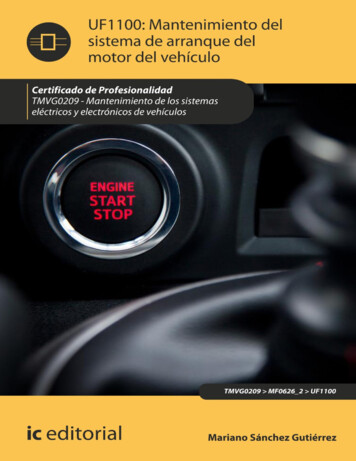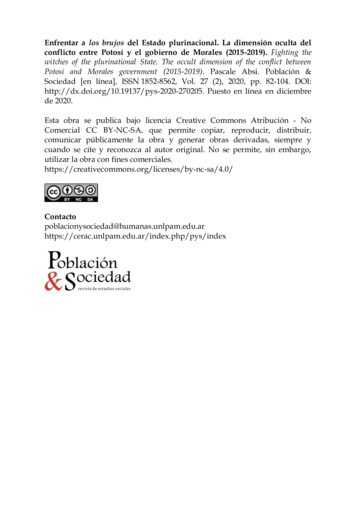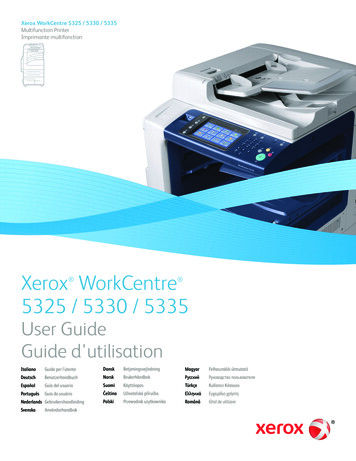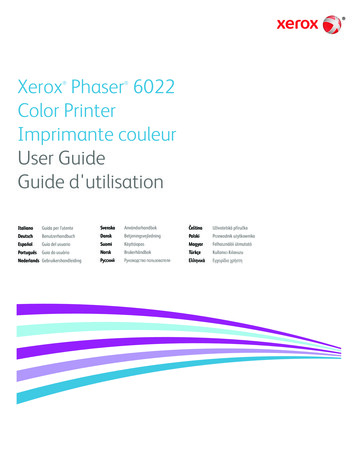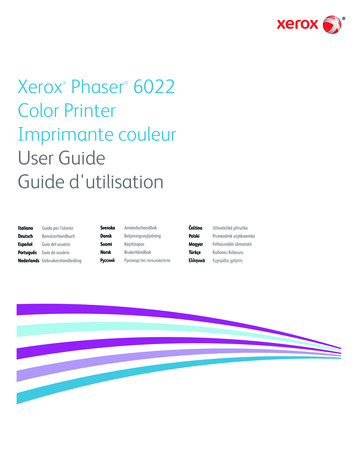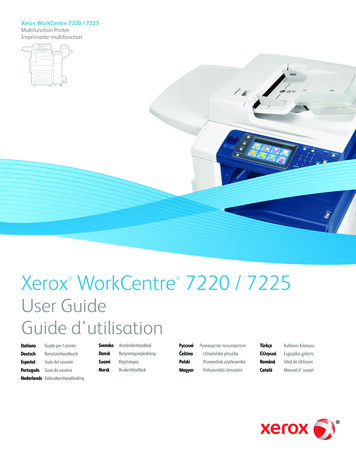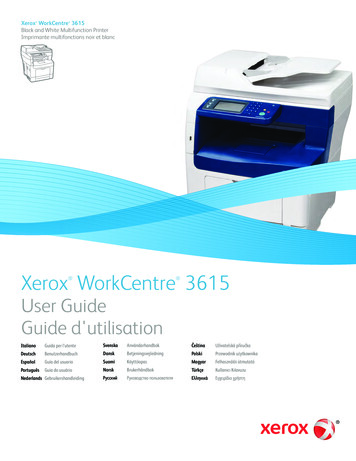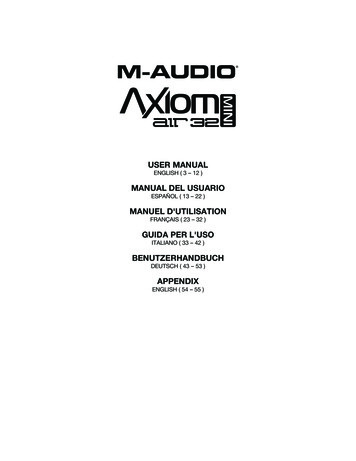
Transcription
USER MANUALENGLISH ( 3 – 12 )MANUAL DEL USUARIOESPAÑOL ( 13 – 22 )MANUEL D'UTILISATIONFRANÇAIS ( 23 – 32 )GUIDA PER L'USOITALIANO ( 33 – 42 )BENUTZERHANDBUCHDEUTSCH ( 43 – 53 )APPENDIXENGLISH ( 54 – 55 )
USER GUIDE (ENGLISH)IntroductionBox ContentsAxiom AIR Mini 32; Mini-USB cable; Software Download Card; User Guide; Safety & Warranty ManualSupportFor complete system requirements, compatibility information, and product registration, visit the supportsection of the M-Audio website: m-audio.com/support.Quick StartSetup Scenario 1Setup Scenario 2ComputerComputerMonitorsHeadphonesUSBMIDI INMIDI OUTRLRLVOLUSB Audio Interface1.2.3.Use the included USB cable to connect your Axiom AIR Mini 32 to an available USB port on yourcomputer. (If you are connecting to a USB hub, ensure that it is a powered hub.) When connectedproperly, and when your computer is on, Axiom's Sustain, Edit, and Octave buttons will illuminate.Open your digital audio workstation (DAW).You may need to open your DAW's Preferences and select your Axiom as the control surface ordevice. See your software's documentation for more information.Recommended DownloadsTo get the most out of your Axiom, we recommend downloading and installing the following files from theirrespective websites: Software: We've included Pro Tools First M-Audio Edition, VIP, and Ableton Live Lite with yourAxiom AIR Mini 32 so you can get started making music with professional software right out of thebox. For Pro Tools First M-Audio Edition and VIP, register your Axiom on m-audio.com, and followthe install instructions in your User Account. For installing Ableton Live Lite, follow the instructions onthe included Ableton Live Lite software download card. Also, visit ableton.com to check for anyavailable software updates. Virtual Instruments: Follow the instructions on the software download card for installing the includedvirtual instrument plugins. After installation, most DAWs will not load virtual instrument pluginsautomatically. In order to access the virtual instrument plugins with Pro Tools First M-Audio Editionand Ableton Live Lite, you will need to choose the plugin folder for the software to scan:Pro Tools First M-Audio Edition (AAX) plugin folders:Windows (32-bit): C:\Program Files (x86)\Common Files\Avid\Audio\Plug-InsWindows (64-bit): C:\Program Files\Common Files\Avid\Audio\Plug-InsmacOS: Macintosh HD/Library/Application Support/Avid/Audio/Plug-Ins3
Ableton/VIP (VST) Plugins:Windows (32-bit): C:\Program Files (x86)\VSTpluginsWindows (64-bit): C:\Program Files\VSTpluginsmacOS: Macintosh HD\Library\Audio\Plugins\VSTTo set your plugin folder in Ableton Live Lite:1.Go to the Preferences menu.2.Select the File Folder tab. Under Plug-In Sources click Browse and select the appropriateplugin folder.3.After making your selection, the Use VST Custom Plug-In Folder button should be ON. If it isnot, click the button to turn it on.4.Exit the Preferences menu. HyperControl personalities (m-audio.com/support): HyperControl offers fast, easy, automaticmapping of the Axiom AIR Mini 32’s buttons and knobs to many frequently used software features andsettings. When used with a supported DAW application, you can control the transport, mixing controls(faders and panning) and virtual instrument or signal processing plug-in parameters. Furthermore, youcan switch between HyperControl and custom MIDI operation on the fly to match your particularneeds. To enable HyperControl with your Axiom, some applications require additional software to beinstalled. Visit m-audio.com/hypercontrol for a current list of applications that support HyperControl. Optional Axiom device drivers for Windows (m-audio.com/support): These drivers let you use yourAxiom with more than one application simultaneously and/or in conjunction with other class-compliantUSB devices with audio capabilities. Mac systems do not need these device drivers.Pro Tools First M-Audio Edition Setup1.2.3.4.5.6.7.Connect Axiom AIR Mini 32 to an available USB port on your computer using the supplied USB cable,and launch Pro Tools First M-Audio Edition.Open or Create a Project.Select the Setup pulldown menu and open MIDI Input Devices. Enable MIDI Input from the Axiomby clicking the box next to the Axiom AIR Mini 32.Select the Setup pulldown menu and open Playback Engine. Choose your audio device from thePlayback Engine pulldown menu.To create a new Instrument track, select the Track pulldown menu and select New.In the New pulldown menu, select Stereo, and then Instrument Track.In the newly created track, add an Insert to your track by clicking in your track's Inserts A-E andselecting Multichannel Plugin Instrument and select the instrument you would like to use, such asXpand!2 (Stereo). The plugin can now be triggered with Axiom AIR Mini 32.Note: Windows users will need either an external soundcard (such as the M-Track 2X2) or a low-latencyASIO driver.Note: Pro Tools First M-Audio Edition does not support VIP.Ableton Live Lite Setup1.2.3.4.5.6.Connect Axiom AIR Mini 32 to an available USB port on your computer using the supplied USB cable,and launch Ableton Live Lite.Next, open the Ableton Live Lite Preferences window. Choose your Audio Device in the Audio tab.This will be dependent upon the audio interface that you are using.PC: Select Options PreferencesmacOS: Select Live PreferencesSelect the MIDI / Sync tab. Within the MIDI Ports section, adjust the settings as seen below:Next to Input: Axiom AIR Mini 32, toggle the On button in the Track and Remote columns.Next to Output: Axiom AIR Mini 32, toggle the On button in the Track and Remote columns.Close the Preferences window.To add an instrument or plugin to Ableton Live Lite in order to generate sound, in the Categoriescolumn, choose Instruments or Plug-Ins.In the Name column, just to the right of the Categories column, locate the Instrument or Plug-in ofyour choice. Click-and-drag the instrument to a MIDI track in Ableton Live Lite to load the instrument.The Instrument can now be triggered with Axiom AIR Mini 32.4
Controls & Connections4 59263811710112131.Keyboard: This 32-note keyboard is velocity-sensitive and, in conjunction with theOCTAVE DOWN/UP buttons, can control a ten-octave range. You can also use it toaccess extended programming functions when your Axiom is in Edit Mode.2.Pitch Bend and Modulation Buttons: These controls let you bend pitch and triggerparameter modulation when controlling a MIDI instrument.3.Octave/Transpose Buttons ( – / ): By default, these buttons shift the keyboard up ordown one octave at a time, extending its playable range. The " " shifts it upward (e.g.,Note F3 becomes F4), while the "–" button shifts it downward (e.g., Note F3 becomesF2). These buttons can also be used to transpose the keyboard in half-steps or to sendMIDI Program Changes and user-assigned MIDI messages.4.Sustain Button: This button acts like the sustain pedal on a piano; it sustains all currentlyheld notes (on the keyboard or trigger pads). Its action can be momentary (sustainingonly when the button is pressed and held) or latching (sustain will be switched on or offwith each button press). To switch the button between momentary and latching behavior,see the Sustain section later in this manual.5.Edit Button: This button puts your Axiom in Edit Mode, allowing you to use itskeyboard's special functions to create or edit MIDI control assignments, global settings,and utility functions. The button will illuminate when the keyboard is in Edit Mode.5
6.Directional Control Buttons: You can use these buttons in HyperControl Mode forvarious navigational functions, depending on your DAW software. You can also assignthem to output standard MIDI messages.7.Transport Controls: These buttons control standard transport functions in DAWsoftware (stop, play, and record). When a HyperControl-enabled DAW is running, thesebuttons automatically map to those functions (or their closest alternatives). You can alsomap these buttons to a variety of MIDI messages.8.Knob Controls: You can use these eight knobs to send standard MIDI messages or totake control of volume, pan, and plug-in parameters in HyperControl Mode (dependingon the setting of the HyperControl Mode button).9.HyperControl Mode Button: This button cycles your Axiom between the following fourcontrol modes: HyperControl Volume Mode: The knobs will control volume levels for the currentlyselected bank of tracks. The Directional buttons, Transport controls, and TriggerPads work in HyperControl Mode, with functions depending on the HyperControlimplementation in your DAW. When this mode is selected, the Volume LED is lit. HyperControl Pan Mode: The knobs will control panning values for the currentlyselected bank of tracks. The Directional buttons, Transport controls, and TriggerPads work in HyperControl Mode, with functions depending on the HyperControlimplementation in your DAW. When this mode is selected, the Pan LED is lit. HyperControl Inst/FX Mode: The knobs will control parameters in the currentlyselected instrument or effects plug-in. The Directional buttons, Transport controls,and Trigger Pads work in HyperControl Mode, with functions depending on theHyperControl implementation in your DAW. When this mode is selected, the Inst/FXLED is lit. MIDI Mode: All Axiom controls send MIDI messages as assigned by the user. ThisMode is selected when none of the HyperControl mode LEDs are lit. (If you are notusing a HyperControl-supported program, this button will be disabled since MIDIMode will be the only mode available.)10. Trigger Pads: These velocity-sensitive trigger pads are perfect for composing drum partsor triggering samples in a live setting.11. Pad Bank Button: This button switches the trigger pads between two assignable banksof MIDI notes.12. USB Port: When Axiom is connected to a computer via USB, this USB connectionpowers Axiom and transmits MIDI data to and from the computer.13. Kensington Security Slot: This connector is compatible with standard laptop-styleKensington security cables for theft protection.6
Edit ModeEdit Mode lets you reconfigure your Axiom's controls and functions in a variety of ways. Please see EditMode Functions in the Appendix for a full-page illustration of all Axiom AIR Mini 32 advanced functions,which you can print and use as a quick visual reference.Octave ButtonsBy default, the Octave " " and "–" buttons shift the keyboard's range up or down one octave at a time.Each time you power up your Axiom, the octave setting will be at the default value of "0," and the buttonswill be red in color at half-brightness.When you use the " " button to raise the octave of the keyboard, it will either illuminate or flash at fullbrightness based on the octave chosen. The "–" will remain at half-brightness. Pressing the "–" button hasthe opposite effect; it will illuminate or flash at full-brightness based on the octave chosen, while the " "button will remain at half-brightness.Each octave is identified by color, as follows: Dim red: 0 (default) Green: 1 or -1 octave Amber: 2 or -2 octaves Red: 3 or -3 octaves Flashing red: 4 or -4 octavesPad LearnMIDI PanicBank LSBBank MSBControl MinimumControl MaximumVelocity CurveEnter9876543210StoreBackupOct TransposeProgram ChangeOct ProgramMemory LocationOct OctaveControl AssignSustain ModeCancelMIDI ChannelModulation RatePitch Bend RateOctave Button keysThe Octave buttons can also be assigned to control two additional MIDI functions: transposition andprogram changes.TransposeYou can also use the Octave " " and "–" buttons to transpose the keyboard, raising or lowering its pitch bya number of semitones (half-steps) as opposed to an entire octave. For example, if you are playing a songwith a singer that is having difficulty singing the top notes, you may want to lower the pitch by one or twosemitones. You can transpose the keyboard a maximum of two octaves in either direction.To assign the Octave " " and "–" buttons to the Transpose function:1.Press the Edit button. It will illuminate to full-brightness.2.Press the Oct Transpose key. The Edit button will return to half-brightness, indicating the Octave " "and "–" buttons now control transposition (and that your Axiom is no longer in Edit Mode).3.Now, you can press the " " or "–" buttons to raise or lower the pitch, respectively.Press both " " and "–" simultaneously to return the keyboard to the default "0" transposition.Program ChangeYou can also use the Octave " " and "–" buttons to send MIDI Program Change messages, moving to thenext highest or lowest program between 0 and 127. Alternatively, you can use your Axiom's ProgramChange button and the numerical keys (0–9) to enter a desired program number.To assign the Octave " " and "-" buttons to send Program Change messages:1.Press the Edit button. It will illuminate to full-brightness.2.Press the Oct Program key. The Edit button will return to half-brightness, indicating the Octave " "and "–" buttons now send Program Change messages (and that your Axiom is no longer in EditMode).3.Now, you can press the " " or "–" buttons to move to the next highest or lowest program,respectively. You can continue playing notes as you move through the programs to hear what eachsounds like.7
To send a Program Change message using the numerical keys:1.Press the Edit button. It will illuminate to full-brightness.2.Press the Program Change key.3.Use the numerical keys (0–9) to enter the desired program number.4.Press the Enter key. The Edit button will return to half-brightness, indicating that you have selected anew Program (and that your Axiom is no longer in Edit Mode).Press both " " and "–" simultaneously to return to the default program "0."Returning the Octave Buttons to Octave ModeTo return the Octave buttons to Octave mode:1.Press the Edit button. It will illuminate to full-brightness.2.Press the Oct Octave key. The Edit Mode button will return to half-brightness, indicating that theOctave buttons control the octave range (and that your Axiom is no longer in Edit Mode).Pitch Bend & Modulation RateBecause the keyboard uses buttons to control the Pitch Bend and Modulation functions (as opposed tovariable controls like wheels), we've added a variable rate feature, which lets you set the rate at which thesebuttons change pitch or modulation (or MIDI values, in MIDI mode).Pad LearnMIDI PanicBank LSBBank MSBControl MinimumControl MaximumVelocity CurveEnter9876543210StoreBackupOct TransposeProgram ChangeOct ProgramMemory LocationOct OctaveControl AssignSustain ModeCancelMIDI ChannelModulation RatePitch Bend RatePitch Bend and Modulation Rate keysTo set the Pitch Bend or Modulation rate:1.Press the Edit button. It will illuminate to full-brightness.2.Press the Pitch Bend Rate or Modulation Rate key.3.Use the numerical keys (0–9) to enter the desired setting (0-127). The settings are as follows: 0: Ramp occurs slowly, over 2 seconds 64 (default, center): Ramp occurs more quickly 126: Ramp occurs very quickly 127: No ramp. Value varies instantly from min to max4.Press the Enter key. The Edit button will return to half-brightness, indicating that you have set thePitch Bend or Modulation rate (and that your Axiom is no longer in Edit Mode).Bank ChangesIf you have a need to switch between banks of programs on a connected instrument, you can send MIDIProgram Changes and Bank LSB (Least Significant Byte) and Bank MSB (Most Significant Byte) messagesright from Axiom.Most instruments have fewer than 127 banks of programs, so bank-switching can be done purely bysending a Bank LSB message (0-127). Bank MSB messages are useful when very large numbers of banksare present. For more information, see your instrument's user guide.Pad LearnMIDI PanicBank LSBBank MSBControl MinimumControl MaximumVelocity CurveEnter98876543210StoreBackupOct TransposeProgram ChangeOct ProgramMemory LocationOct OctaveControl AssignSustain ModeCancelMIDI ChannelModulation RatePitch Bend RateBank LSB and Bank MSB keys
To send a Bank LSB or Bank MSB message:1.Press the Edit button. It will illuminate to full-brightness.2.Press the Bank LSB or Bank MSB key, depending on the kind of message you want to send.3.Use the numerical keys (0–9) to enter the desired bank value (0-127).4.Press the Enter key. The Edit button will return to half-brightness, indicating that you have sent theBank LSB or Bank MSB message (and that your Axiom is no longer in Edit Mode).SustainThe Sustain button acts like the sustain pedal on a piano; it sustains all currently held notes (on thekeyboard or trigger pads). Its action can be momentary (sustaining only when the button is pressed andheld) or latching (sustain will be switched on or off with each button press).Pad LearnMIDI PanicBank LSBBank MSBControl MinimumControl MaximumVelocity CurveEnter9876543210StoreBackupOct TransposeProgram ChangeOct ProgramMemory LocationOct OctaveControl AssignSustain ModeCancelMIDI ChannelModulation RatePitch Bend RateSustain keyTo select the desired Sustain button mode:1.Press the Edit button. It will illuminate to full-brightness.2.Press the Sustain Mode key to switch between momentary and latching behavior.3.Wait one second. Your Axiom will automatically exit Edit Mode.Velocity CurvesThe keyboard and trigger pads on Axiom are velocity-sensitive; playing with more force results in a highervolume, while playing with less force results in a lower volume. This dynamic range gives your performancea more natural sound and feel. You can vary the touch sensitivity of the keyboard by selecting a velocitycurve, tailoring the keys' response to your particular playing style.To select a velocity curve:1.Press the Edit button. It will illuminate to full-brightness.2.Press the Vel Curve key.3.Use the numerical keys (0–9) to enter the desired value (0-127). The velocity curve settings are asfollows: 0: Low velocity curve (low sensitivity) 1 (default): Normal velocity curve (default sensitivity) 2: High velocity curve (high, exponential sensitivity) 3: Stepped velocity (outputs only velocity values 100 and 127) 4-127: Fixed velocity (outputs only a fixed velocity from 4 to 127)4.Press the Enter key to save the new velocity curve setting, or press Cancel or Edit to exit Edit Modeand discard any new settings.Pad LearnMIDI PanicBank LSBEnter9876543210Store9Bank MSBControl MinimumControl MaximumVelocity CurveBackupOct TransposeProgram ChangeOct ProgramMemory LocationOct OctaveControl AssignSustain ModeCancelMIDI ChannelModulation RatePitch Bend RateVelocity Curve key
Trigger PadsYou can easily assign sounds from the keyboard to the trigger pads by using the Pad Learn function. Thiscan be useful if you want to use the trigger pads to send certain MIDI notes to trigger a sound in your virtualinstrument.Pad LearnMIDI PanicBank LSBBank MSBControl MinimumControl MaximumVelocity CurveEnter9876543210StoreBackupOct TransposeProgram ChangeOct ProgramMemory LocationOct OctaveControl AssignSustain ModeCancelMIDI ChannelModulation RatePitch Bend RatePad Learn keyTo assign the MIDI note of a trigger pad:1.Press the Edit button. It will illuminate to full-brightness.2.Press the Pad Learn key.3.If necessary, press the Pad Bank button to select the pad bank containing the desired pad.4.Press a keyboard key to select the desired MIDI note.5.Press the desired trigger pad to assign the chosen note to the pad. Your Axiom will automatically exitEdit Mode.MIDI SettingsPad LearnMIDI PanicBank LSBBank MSBControl MinimumControl MaximumVelocity CurveEnter9876543210StoreBackupOct TransposeProgram ChangeOct ProgramMemory LocationOct OctaveControl AssignSustain ModeCancelMIDI ChannelModulation RatePitch Bend RateMIDI Panic keyMIDI Channel keyGlobal MIDI ChannelThe "global" MIDI channel is the default MIDI channel over which Axiom sends MIDI messages. Becausethis is a global setting, it applies across all memory locations, overridden only by custom channel selectionsfor controls in MIDI Mode.To set the global MIDI Channel:1.Press the Edit button. It will illuminate to full-brightness.2.Press the MIDI Channel key.3.Use the numerical keys (0–9) to enter the desired MIDI channel (1-16).4.Press the Enter button to save the new global MIDI channel assignment, or press Cancel or Edit to exitEdit Mode and discard any new settings.MIDI PanicWhen you trigger a MIDI Panic message, it sends an "All Notes Off" message on all channels and throughall outputs. This is useful when a connected hardware or software synthesizer has a stuck Note On.To send a MIDI Panic message:1.Press the Edit button. It will illuminate to full-brightness.2.Press the MIDI Panic key. An "All Notes Off" MIDI message will be sent. Your Axiom will automaticallyexit Edit Mode.10
Custom MIDI ConfigurationWhen you want more control flexibility than HyperControl Mode offers, you can many of Axiom AIR Mini32's knobs and buttons to output a variety of MIDI messages.Assigning MIDI Messages to ControlsEditing Axiom's MIDI configuration all starts with the Edit button. Pressing Edit causes your Axiom to enterEdit Mode. The Edit button will flash to signify the Edit Mode is selected.To exit Edit Mode, press the Edit button a second time.Pad LearnMIDI PanicBank LSBBank MSBControl MinimumControl MaximumVelocity CurveEnter9876543210StoreBackupOct TransposeProgram ChangeOct ProgramMemory LocationOct OctaveControl AssignSustain ModeCancelMIDI ChannelModulation RatePitch Bend RatePad Learn keyMIDI Channel keyTo assign a specific MIDI message to a physical control:1.Press the Edit button. It will illuminate to full-brightness.2.Select the control to assign by moving or pressing it.3.Press the Control Assign key to enter Control Assign Mode.4.Use the numerical keys (0–9) to enter the desired MIDI message type (0-127, 129, or 130) for thiscontrol: 0-127: MIDI CC; works with all controls except Octave/Transpose buttons 129: Pitch Bend; works with all knobs and Pitch Bend buttons. 130: MMC (MIDI Machine Control); works with Transport buttons only (sets each button tostandard MMC values)5.Press the Enter button to save the new assignment, or press Cancel or Edit to exit Edit Mode anddiscard any new settings.Control Min/MaxIn some cases you may want to set a minimum and/or maximum control value for a knob or button, tobetter align that control to a desired range of values.Pad LearnMIDI PanicBank LSBBank MSBControl MinimumControl MaximumVelocity CurveEnter9876543210StoreBackupOct TransposeProgram ChangeOct ProgramMemory LocationOct OctaveControl AssignSustain ModeCancelMIDI ChannelModulation RatePitch Bend RateControl Max and Control Min keysTo set the minimum or maximum value sent by a control:1.Press the Edit button. It will illuminate to full-brightness.2.Select the control to edit by moving or pressing it.3.Press the Control Min key or Control Max key.4.Use the numerical keys (0–9) to enter the desired value (0-127).5.Press the Enter button to save the new setting, or press Cancel or Edit to exit Edit Mode and discardany new settings.Customize MIDI Assignments in HyperControlWhen using your Axiom with a HyperControl-enabled DAW, you can access your custom MIDIconfigurations by pressing the HyperControl Mode button until none of the mode LEDs are lit. To return toHyperControl Mode, press the button until the desired HyperControl mode LED is lit.11
Memory LocationsOnce you've made some MIDI control assignments to fit a specific device or task, you may want to savethem to one of Axiom's 10 memory locations for later use.Pad LearnMIDI PanicBank LSBBank MSBControl MinimumControl MaximumVelocity CurveEnter9876543210StoreBackupOct TransposeProgram ChangeOct ProgramMemory LocationOct OctaveControl AssignSustain ModeCancelMIDI ChannelModulation RatePitch Bend RateMemory Location keyStore keyTo store the current set of MIDI assignments to a memory location:1.Press the Edit button. It will illuminate to full-brightness.2.Press the Store key.3.Use the numerical keys (0–9) to enter the desired memory location slot (0-9). Your Axiom willautomatically exit Edit Mode.To recall a memory location:1.Press the Edit button. It will illuminate to full-brightness.2.Press the Memory Location key.3.Press the numerical key (0-9) to select its memory location. Your Axiom will automatically exit EditMode.Memory Backup & RestoringYou can back up and restore individual memory locations or the entire memory (10 locations) of your AxiomAIR Mini 32 using MIDI SysEx. Use a SysEx librarian application or simply record it to a MIDI track in yourDAW and play it back when needed.Pad LearnMIDI PanicBank LSBBank MSBControl MinimumControl MaximumVelocity CurveEnter9876543210StoreBackupOct TransposeProgram ChangeOct ProgramMemory LocationOct OctaveControl AssignSustain ModeCancelMIDI ChannelModulation RatePitch Bend RateMemory Location Backup keyTo backup one or all memory locations:1.Ensure that Axiom is connected to the computer and functioning correctly.2.Ensure that a MIDI track in your DAW is recording (and set to receive MIDI from Axiom), or that yourSysEx librarian utility is ready to receive data.3.Press the Edit button. It will illuminate to full-brightness.4.Press the Backup key. Your Axiom will automatically exit Edit Mode.To restore one or all memory locations from a MIDI backup:1.Ensure that Axiom is connected to the computer andfunctioning correctly.2.Ensure that your DAW (with a MIDI track containingbackup data) or SysEx librarian utility is set to transmitMIDI to your Axiom.*3.Press Play on your DAW or enable SysEx transmission onyour SysEx librarian application. Your Axiom willautomatically exit Edit Mode.12* Before loading SysEx data from aMIDI track in your DAW, ensure thatthe transport or playhead ispositioned before the desired datain the timeline.
GUÍA DEL USUARIO (ESPAÑOL)Contenido de la cajaAxiom AIR Mini 32; cable mini USB; Guía del usuario; Manual sobre la seguridad y garantíaSoportePara obtener información sobre los requisitos completos de sistema, la compatibilidad y el registro delproducto, visite la sección de soporte del sitio web de M-Audio: m-audio.com/support.Inicio rápidoEscenario de instalación 1Escenario de instalación 2ComputadoraComputadoraMonitoresAuricularesUSBMIDI INMIDI OUTRLRLVOLInterfaz Audio USB1.2.3.Use el cable USB incluido para conectar su Axiom a un puerto USB disponible en la computadora. (Sise conecta a un concentrador (hub) USB, asegúrese de que sea un concentrador alimentado).Cuando está conectado correctamente y su computadora está encendida, se iluminan los botonesSustain (Sostenido), Edit (Edición), y Octave (Octava) del Axiom.Abra su estación de trabajo de audio digital (DAW).Es posible que deba abrir Preferences (Preferencias) de su DAW y seleccionar su Axiom comosuperficie o dispositivo de control. Para más información, consulte la documentación de su software.Descargas recomendadasPara obtener lo máximo de su Axiom, recomendamos bajar e instalar los siguientes archivos desde sussitios web respectivos: Software: Hemos incluido Pro Tools First M-Audio Edition, VIP y Ableton Live Lite con su Axiom AIRMini 32 de modo que puede comenzar a hacer música con software profesional en cuanto lo saca dela caja. Para Pro Tools First M-Audio Edition y VIP, registre su Axiom AIR Mini 32 en m-audio.com ysiga las instrucciones de instalación en su Cuenta de usuario. Para la instalación del Ableton Live Lite,siga las instrucciones incluidas en la tarjeta de descarga de software del Ableton Live Lite. Visitetambién ableton.com para comprobar si hay actualizaciones de software disponibles. Instrumentos virtuales: Siga las instrucciones de la tarjeta de descarga de software para instalar losplugins de instrumentos virtuales incluidos. Tras la instalación, muchos DAW no cargarán plugins deinstrumentos virtuales de forma automática. A fin de acceder a los plugins de instrumentos virtualescon Pro Tools First M-Audio Edition y Ableton Live Lite, deberá seleccionar la carpeta con pluginspara que el software explore:Carpetas de plugins de Pro Tools First M-Audio Edition (AAX):Windows (32-bit): C:\Program Files (x86)\Common Files\Avid\Audio\Plug-InsWindows (64-bit): C:\Program Files\Common Files\Avid\Audio\Plug-InsmacOS: Macintosh HD/Library/Application Support/Avid/Audio/Plug-Ins13
Plugins de Ableton (VST):Windows (32-bit): C:\Program Files (x86)\VSTpluginsWindows (64-bit): C:\Program Files\VSTpluginsmacOS: Macintosh HD\Library\Audio\Plugins\VSTPara establecer su carpeta de plugins en Ableton Live Lite:1.Vaya al menú Preferences (Preferencias).2.Seleccione la pestaña File Folder (Carpeta de archivos). Bajo Plug-In Sources (Fuentes de plugin)haga clic en Browse (Explorar) y seleccione la carpeta de plugins apropiada.3.Después de hacer su selección, el botón Use VST Custom Plug-In Folder (Usar carpeta de pluginspersonalizada) debe estar en ON (encendido). Si no lo está, haga clic en el botón para encenderlo.4.Salga del menú Preferences (Preferencias). Personalidades (perfiles) de HyperControl (m-audio.com/support): HyperControl ofrece una asignaciónautomática rápida y sencilla de los botones del Axiom AIR Mini 32 a numerosas funciones y configuracionesde software de uso frecuente. Cuando lo usa con una aplicación compatible con la DAW, es posible controlarel transporte, los controles de mezcla (faders y balanceo) y los parámetros de plug-in de procesamiento deseñales o instrumentos virtuales. Además, es posible conmutar entre HyperControl y la operación MIDIpersonalizada sobre la marcha, a fin de satisfacer sus necesidades particulares. Para habilitar HyperControlcon el Axiom AIR Mini 32, algunas aplicaciones requieren instalar software adicional. Para obtener una lista delas aplicaciones compatibles con HyperControl, visite m-audio.com/hypercontrol. Drivers de dispositivos opcionales de Axiom para Windows (m-audio.com/support): Estos drivers lepermit
Ableton Live Lite Setup 1. Connect Axiom AIR Mini 32 to an available USB port on your computer using the supplied USB cable, and launch Ableton Live Lite. 2. Next, open the Ableton Live Lite Preferences window. Choose your Audio Device in the Audio tab. This will


